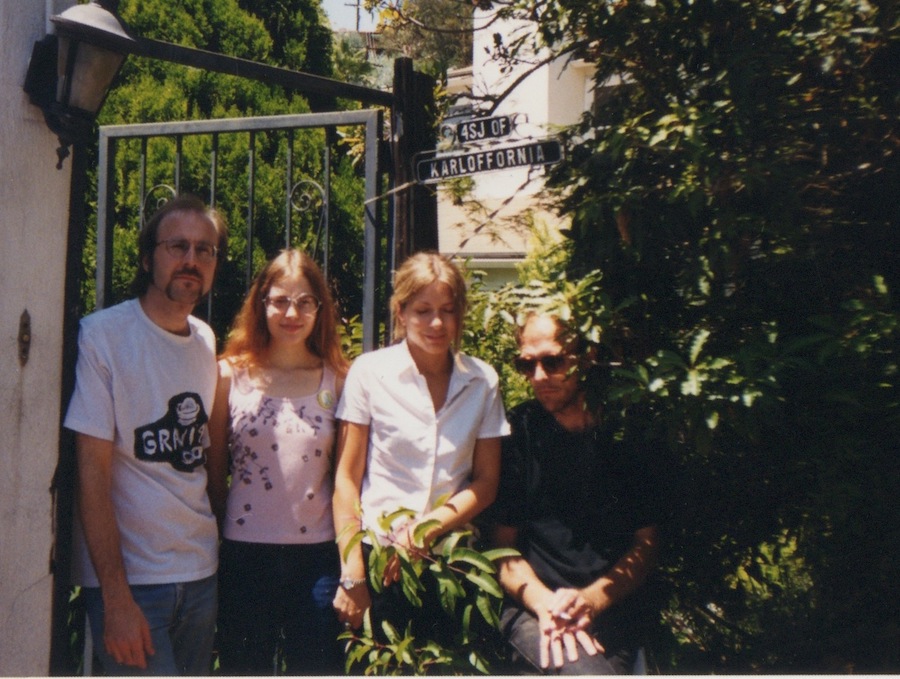Musician Matthew Smith attended University of Michigan in the 1980s with the intention of following a career in film. We asked Smith to comment on Uhle’s book, the Ann Arbor film scene in the eighties, and the beginnings of Outrageous Cherry. ~Ed.
The Book Beat will be hosting a signing and discussion with Frank Uhule on Cinema Ann Arbor on Sunday June 25 from 3-4 pm. Detroit musician Matthew Smith will help moderate the discussion. The book can be purchased online at the Book Beat Gallery. An interview with Frank Uhle can be read at Dreaming in the Dark.

Outrageous Cherry in 1999, at the Ackermansion in Hollywood after hanging out with Forrest J. Ackerman of Famous Monsters of Filmland. (L-R Matthew Smith, Aran Ruth, Deb Agolli, Larry Ray), photo by Eugene Strobe
CINEMA ANN ARBOR by Frank Uhle
recollections/ramblings by Matthew Smith
I attended the University of Michigan from 1982 to 1987, and as a film student and film society member, I got to experience Ann Arbor’s cinema culture at its peak. I also witnessed its rapid demise when video cassettes suddenly became more popular than projected films.
Ann Arbor always played an important role in the history of underground cinema. Frank Uhle’s book CINEMA ANN ARBOR explores how film culture in and around the University of Michigan thrived as a subversive subculture, continually at odds with the establishment. Even in the earliest days of cinema, more than a century ago, it seems that Ann Arbor’s film societies were a nexus for outsiders, artists and people who generally didn’t fit in with whatever the established “program” was at the time.
As a student in Ann Arbor, I spent most of my time watching films. By day in film classes and in the evenings in auditorium showings sponsored by film societies, and often again after midnight in someone’s apartment with a borrowed 16mm projector. Sometimes 3 or 4 films a day.
After graduating, I had intended to continue making the kind of weird experimental films I’d been making as a student, but it was getting more complicated and expensive to work with actual film during the age of video, so I concentrated on making music instead. Also, the video technology in those days looked so crummy compared to film, that I just had no interest in it at all.
Author Frank Uhle, who quotes me in his book a few times, was already a member of the Cinema 2 organization at the time I joined, and he knew more about obscure films and records than just about anyone. Frank turned me on to all kinds of films, ranging from obscure Jean Renoir films and Film Noir to the most bizarre 60’s drive-in features. Frank also played me a lot of obscure psychedelic music. Most importantly, Frank gave me a stack of records by the Beach Boys when he apparently realized that I didn’t fully appreciate their greatness, and then he introduced me to a fellow record collector and musician from Detroit named Larry Ray.
I eventually started a Beach Boys-obsessed rock band with Larry Ray called Outrageous Cherry that lasted more than 25 years, so Frank’s influence was definitely a part of that.
Frank’s study of Ann Arbor’s cinema societies investigates the history of this subculture of all these people who were just totally obsessed with cinema 24 hours a day, talking about films non-stop when they weren’t watching films, and still finding time to interact with the worlds of music and visual art and even making movies themselves.
The Ann Arbor Film Festival had turned Ann Arbor into the capitol of weird short experimental films. The festival was directly influenced by ideas that had been coming out of the ONCE Festival, the early 60’s avant-garde music festival that had helped to establish a notable avant-garde subculture in Ann Arbor by the early 60’s.
CINEMA ANN ARBOR is populated by an amazing array of characters, and there are many fascinating previously unseen photos: The Velvet Underground in 1966 playing their first gig outside of New York on a floor in front of a bunch of students with Warhol’s films projected on them. Pat Oleszko combining burlesque and sculpture and film in new forms of performance art. The Stooges in 1968 playing on a bill with a program of cartoons. Minimalist composer Alvin Lucier starring as an actor in underground movies. Director Frank Capra visiting Ann Arbor, having arrived carrying film canisters containing “It’s a Wonderful Life”. Robert Altman walking around very stoned onstage with an umbrella. There are controversies, like the arrests of film society members for attempting to show Jack Smith’s “Flaming Creatures”. Also there was the debate of whether or not to show D.W. Griffith’s notorious “Birth of a Nation”, which is both a technical milestone in cinema and a profoundly dangerous work of racist propaganda.
When I arrived at U of M in 1982, the film scene was still going strong and hadn’t changed much since the 60’s and 70’s. It was just non-stop films, every day, all the time. By the time I’d graduated and left Ann Arbor in 1987, the whole scene had fragmented and dispersed. Frank’s book details how, in an age where watching videos at home suddenly became an alternative to going to the movies, Ann Arbor’s struggling film culture gradually slipped away. What we have here is a stunning document, with stories and visuals, of a significant counterculture movement. Frank Uhle was deeply involved with this scene, and he’s interviewed everyone he could find to talk about everything that was going on back in the days when a bunch of people sitting in dark rooms watching flickering images was a kind of religion.
